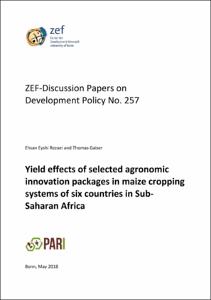Yield effects of selected agronomic innovation packages in maize cropping systems of six countries in Sub-Saharan Africa

Yield effects of selected agronomic innovation packages in maize cropping systems of six countries in Sub-Saharan Africa

| dc.contributor.author | Eyshi Rezaei, Ehsan | |
| dc.contributor.author | Gaiser, Thomas | |
| dc.date.accessioned | 2022-02-18T09:28:14Z | |
| dc.date.available | 2022-02-18T09:28:14Z | |
| dc.date.issued | 05.2018 | |
| dc.identifier.uri | https://hdl.handle.net/20.500.11811/9632 | |
| dc.description.abstract | Implementation of suitable innovation packages into cropping systems is required to address the issues of food security and improvement of the crop yield in Sub-Saharan Africa. However, quantification of the effects of innovation packages such as increase in fertilizer application rates, introduction of high yielding cultivars or change in farming practices such as sowing date and irrigation, generally requires substantial investments, in particular the quantification at large scales. Crop models are widely employed to estimate the impacts of agronomic decisions on cropping systems and to detect the most suitable areas for their implementation. The main goal of the study is to quantify the effects of a) change in nitrogen fertilization rate, b) adjustment of sowing date, c) implementation of new cultivars, and d) supplementary irrigation on maize cropping systems across six African countries including Ghana, Nigeria, Kenya, Malawi, Ethiopia and Burkina Faso. For this purpose, 30 years (1980-2010) of climate data are used as well as soil and management information obtained from global datasets at 0.5° x 0.5° spatial resolution. The nitrogen and cultivar packages were tested for all six countries whereas the changes in sowing dates (Ghana and Malawi) and the irrigation (Ethiopia) package were used in specific countries only. The crop modelling framework SIMPLACE was used to test the effects of innovation packages at the country level. The model results indicated that the agronomic innovation packages could improve maize yield by 1 t ha-1 to 2.3 t ha-1 in the studied countries. The magnitude of the yield improvement is country and package specific. The largest maize yield improvements across the packages were obtained by increase in nitrogen application rate, assuming that other nutrients like phosphorus and potassium are not limiting crop growth and yield. However, in some cases a combination of the agronomic innovation packages showed the highest maize yield. We conclude that it is vital to combine the agronomic packages to fill the gap between potential and current yields of maize in Africa. This will require appropriate incentives and investments in extension services, fertilizer distribution networks, and farmer capacity building. | en |
| dc.format.extent | 26 | |
| dc.language.iso | eng | |
| dc.relation.ispartofseries | ZEF Discussion Papers on Development Policy ; 257 | |
| dc.rights | In Copyright | |
| dc.rights.uri | http://rightsstatements.org/vocab/InC/1.0/ | |
| dc.subject | Africa | |
| dc.subject | Crops | |
| dc.subject | Fertilizer | |
| dc.subject | Seeds | |
| dc.subject | Irrigation | |
| dc.subject | Agricultural production | |
| dc.subject.ddc | 333.7 Natürliche Ressourcen, Energie und Umwelt | |
| dc.subject.ddc | 360 Soziale Probleme, Sozialdienste, Versicherungen | |
| dc.subject.ddc | 500 Naturwissenschaften | |
| dc.subject.ddc | 630 Landwirtschaft, Veterinärmedizin | |
| dc.title | Yield effects of selected agronomic innovation packages in maize cropping systems of six countries in Sub-Saharan Africa | |
| dc.type | Arbeitspapier | |
| dc.publisher.name | Center for Development Research (ZEF) | |
| dc.publisher.location | Bonn | |
| dc.rights.accessRights | openAccess | |
| dc.relation.pissn | 1436-9931 | |
| dc.relation.doi | https://doi.org/10.22004/ag.econ.273119 | |
| ulbbn.pubtype | Zweitveröffentlichung |




